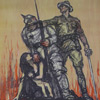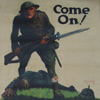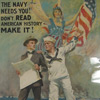Lesson Plans
First Call: American Posters of World War I
“First Call: American Posters of World War I” is an educational program appropriate for 4th - 12th grade students that takes a look at World War I propaganda posters. This program is offered on-site at the Museum and as part of our outreach programming. “First Call” includes lesson plans, PowerPoint presentations, worksheets, and hands-on experience with primary sources. Groups as large as 200 are acceptable for this program. For more information or to reserve your presentation please contact Stephan McAteer, smcateer@littlerock.org, or 501-376-4602.
“First Call: American Posters of World War I” is funded by Mrs. Helen T. Leigh in memory of her husband Lt. Col. Gilbert Leigh, U.S. Air Force. Posters are from the MacArthur Museum of Arkansas Military History Collection.
First Call: American Posters of World War I Lesson Plan (Word, new window)
Images of War Posters for Analysis by Students
Fundraising Posters
Recruiting Posters
Red Cross Posters
Conservation Posters
United War Work Campaign Posters
The enormous output of posters in the United States during and just after the first World War belies this country’s late entry into that conflict. Spurred by the example of various European combatants, the creation and production of appropriate “pictorial publicity” quickly achieved a high level of artistic involvement and industrial application. Thousands of designs were created and most of them were printed in large numbers. As a result few of these posters are scarce even today, and only a handful qualify as “rare.” A large number of artists were involved in the creation of posters. Some of them, such as Howard Chandler Christy and James Montgomery Flagg, came to the work with their reputations already secured through their commercial work in books, magazines, and advertising. Many of the artists, whether obscure or famous, contributed their work “gratis” to the war effort.
The posters helped not only with the obvious aim of recruiting members for the armed forces, but with the parallel home-front efforts embodied in various conservation efforts, such as the United War Work Campaign, the Red Cross and perhaps most notably in the rapid subscription of the Liberty and Victory Loans. Posters commonly urged wartime thrift and were vocal in seeking funds from the general public via subscription to the war bond efforts.
Each of the four Liberty Loan Campaigns (two in 1917, two in 1918) and the Victory Loan Campaign of 1919, brought an outpouring of poster art on both the local and national levels. The Liberty and Victory Loan drives raised approximately 30 billion dollars and did much for the proliferation of the poster as an important means of war effort communication. Interestingly, despite the U.S. late entry into the war, this country produced more propaganda posters than any other single nation.
![]()































